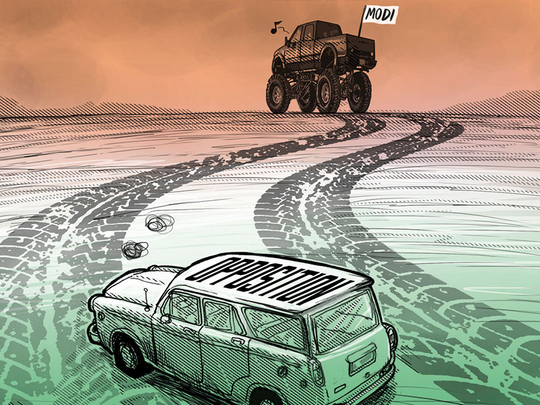
It’s more or less certain that India will see a general election in early 2019.
A little over a fortnight ago, when the monsoon session of parliament began, the combative speech that the Congress president and the Opposition leader, Rahul Gandhi, made was one of the best he delivered in recent times. That set the tone of what is likely to be a sharply acrimonious campaign a few months from now.
The speech was almost entirely directed against the Prime Minister Narendra Modi. Whether it was the upwardly revised Rafael fighter jet defence contract, the Rs140 billion (Dh7.43 billion) Nirav Modi scam involving the diamond merchant defrauding the Punjab National Bank, a public sector institution, the demonetisation decision from which the middle class and traders have yet to recover, or the sporadic lynchings of Muslims by Hindu fanatics and the relative silence that Modi has maintained on the issue, the Congress’s strategy has been to hold the prime minister personally accountable.
This may come across as unfair. After all, the government is a complex machinery, and policies are decided at the cabinet level. But it must dawn on even a Modi fan that this is essentially a one-man government. Nothing stirs without his nod.
In the past, Modi has said he barely has a full night’s sleep; that he has not had a vacation in years. Modi has been evidently one of the hardest working prime ministers of India, a country that looks down upon people who take earned holidays, though her work culture generally condones lack of productivity and incompetence.
Modi and his millions of fans will argue with figures (the share market is at an all time high, the GDP growth is predicted at over 7 per cent) that have no way of being cross checked that his government is delivering. If India indeed is cruising, then the credit will pile up at Modi’s door. If it is not, that too will be Modi’s doing as this is one of the most centralised governments in Indian history since Indira Gandhi’s time.
Which is why Rahul Gandhi has been rather custom-tailoring his speeches. On Saturday, a high-level meeting of the Congress Party, conducted in the absence of Sonia Gandhi, possibly to give the impression that the party’s decision making process is unified in the person of Rahul Gandhi, resolved to stay the course of personally holding Modi responsible for all the perceived problems. The idea clearly is to shake the tinsel and glitz off the brand image of Modi as the agent of change and the architect of a new India, a dream both BJP and the Congress would like to sell.
Gandhi recently quoted low job growth figures, farmer suicides, fuel price hike, falling rupee as indicators of the reality. For the average Indian, if his quotidian experience is anything, what Gandhi says will hold true. India’s ability to save has come down while expenses have gone up. The country’s uncertainties have spawned more anxieties. No matter. India still believes Modi will deliver. Over four years in power, Modi’s image as a hard working PM, out to settle India’s future still holds. He manages the perception battle to his great advantage.
Din of diversions
The Modi government has dropped one red herring after another, perhaps in an effort to control the overall narrative that goes well with the Hindu majoritarians at the core of the BJP mandate. The latest in this series has been the National Register of Citizens (NRC) that found some 4 million Assamese as illegal immigrants, pending appeal. The dust and the din raised by these diversions protect Modi, gives him time to gather his forces and thoughts.
The problem of strategy for the Opposition in general and Rahul Gandhi in particular boils down to precisely that: reactive. Despite their efforts to hold the PM personally responsible even for the weather — and the monsoon has been plentiful this time, always a good sign of India’s immediate agricultural fortune — it is clear Modi’s detractors do not have an alternative finance and economy model to ride the next ballot wave. This is despite the fact that the Congress and liberal India have greater intellectual depth and resources than the BJP.
As things stand, Modi is set for re-election. A victory will give him time till 2024 to consolidate on his initiatives. In short, it will take another generation of Indians to bring Modi down. With luck. Secular and liberal India is in for a shock. Their time to step out of the grandstanding and outrage bubble is now. A good step in that direction would be not to confuse the social media for the real thing. Those who speak all the time the loudest are not the ones always being heard.
C.P. Surendran is a senior journalist based in India.










